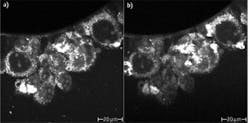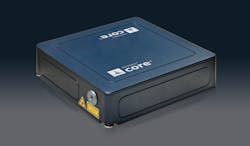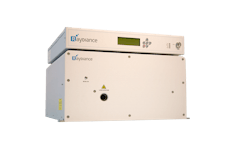A millionth of a billionth of a second makes up one femtosecond. With lasers available in that range, biologists can see deeper and more accurately and some medical procedures reach new realms of precision. To better understand just how advances in femtosecond lasers are impacting life sciences, I turned to ultrafast laser experts at Coherent (Santa Clara, CA), Femtolasers Produktions (Vienna, Austria), Raydiance (Petaluma, CA), and Spectra-Physics, a Newport Corp. brand (Santa Clara, CA).
These devices change the extent of what biologists can see. "With femtosecond lasers, you can see things that are usually not accessible with other methods," says Andreas Stingl, president and CEO of Femtolasers Produktions.
That capability comes from particular consequences of using a femtosecond laser. "It allows you to do in-depth or 3D imaging in live tissue without damaging it," says Herman Chui, senior director of product marketing at Spectra-Physics. Those capabilities benefit many optical applications in biology.Pinching the pulses
For lasers in general, pulses have shrunk over the years. Some of today's lasers can generate pulses of 100–300 fs. "Soon we will see pulses of only 10–20 fs in lasers," says Stingl. "That's a very smart way to increase peak power while reducing average power." Too much average power creates heat that can destroy biological samples. So femtosecond lasers can be used to illuminate a sample over longer stretches, or more times, without causing as much damage as a longer-pulse laser might.
The shorter-pulse lasers also work well in multiphoton microscopy, where more than one photon is necessary to excite a label. Stingl says, "We have developed a femtosecond laser for multiphoton microscopy that provides four times higher repetition rates—more than 300 MHz—and five times shorter pulses—less than 20 fs—compared to conventional short-pulse lasers. This combination is really ideal, because it provides more photons and the shorter pulses enhance the contrast."
The precise interaction between a tissue and a femtosecond laser beam also makes these light sources ideal for multiphoton microscopy. For example, Mike Mielke, chief scientist at Raydiance, says that a femtosecond laser can cover an area just 10–25 μm across. He adds, "Our lasers typically work in microjoules, which is pretty low energy by macroscopic standards." That low energy contributes to being able to use mutliphoton microscopy without damaging or changing the sample.It's not just the laser pulse that matters, though, because the light must also be delivered to a target. Dispersion during delivering the light, such as when it travels through a microscope, can stretch it—turning a shorter pulse into a longer one. Stingl says, "Our FEMTOOPTICS are designed to support broadband, ultrashort pulses to make sure that the laser can develop its full performance at the target." The benefits of femtosecond lasers are utilized best if the pulse stays about the same length when it gets to where it does its work, such as exciting a fluorescent label.
All of the parts—laser, optics, and electronics—could make femtosecond lasers look intimidating. In fact, using any laser took lots of experience at one time, and a femtosecond laser once required an expert to keep it working. That's not true today. "Today's femtosecond laser systems are stable," says Matthias Schulze, director of marketing at Coherent. "You can make femtosecond lasers that are hands-off and reliable."
Here, again, keeping the pulses short is extremely important, and that can be accomplished in different ways. To keep those pulses narrow and with enough peak power to reach the targeted tissue, Coherent equips its femtosecond lasers with precompensation that prepares the beam for dispersive optics.
Today's femtosecond lasers also allow deeper three-dimensional sectioning in multiphoton microscopy. That comes from the longer wavelength femtosecond lasers that are now available. For example, the InSight DeepSee femtosecond laser from Spectra-Physics provides up to 1300 nm wavelengths. "You can image much deeper because you can operate at very long wavelengths," says Chui. This laser also offers flexibility, because it can go from 1300 down to 680 nm in a single beam. "It's a flexible tool that's easy to use," Chui says. "The entire laser system, including wavelength and dispersion tuning, is completely computer-controlled."
Improving human optics
In some cases, femtosecond lasers play a role in nature's ultimate biological optics, the human eye. "Femtosecond lasers are very important in ophthalmology," says Stingl. For example, these devices can be used in refractive corneal surgery, where a surgeon reshapes the cornea—the transparent layer over the front of the eye—to improve a patient's vision. According to Peter Kim, an ophthalmic surgeon at Toronto Western Hospital in Canada, and his colleagues' writing in the June 2001 Current Opinions on Ophthalmology, "The femtosecond laser has become a rapidly and widely adopted technology for surgeons performing refractive surgery." According to Schulze, about 70 percent of the procedures in the United States now use a laser to make these cuts.
In addition, eye surgeons can apply femtosecond lasers to cataract surgery, where the eye's lens gets replaced with an artificial one. Here, surgeons use a femtosecond laser for the cuts needed for this procedure. Specifically, this involves an optical coherence tomography (OCT)-guided femtosecond laser. In a test of incisions made manually vs. an OCT-guided femtosecond laser, Neil J. Friedman, an ophthalmic surgeon at Stanford University, and his colleagues reported in the July 2011 Journal of Cataract & Refractive Surgery: "The femtosecond laser produced capsulotomies that were more precise, accurate, reproducible, and stronger than those created with the conventional manual technique."
So the short length of pulses created by femtosecond lasers increases the accuracy of various approaches to eye surgery. Undoubtedly, these tools will also be used in other medical applications. Likewise, femtosecond lasers—especially as they improve to create pulses just a handful of femtoseconds long—will expand to even more research applications. As shown here, though, the use of these lasers in any optical application depends on a complete system. It is not enough to make extremely short laser pulses—they must also be delivered. Furthermore, enhancements in the lasers, such as longer wavelengths, allow the light signal to be used in even more areas, such as deeper imaging. Such combinations of technology promise to turn femtosecond lasers into even more powerful tools.


